MATH300 Midterm: MATH 300 UofA Exam Solution 2
Document Summary
The average rate of change of a function on an interval is essentially the formula for the slope. Lines are de ned by the fact that they have a constant slope: if f (x) is an increasing function, explain why f (x) 0. The value of f (a) at any point x = a is the limit of values of the average rate of change on small intervals, f (b) f (a) where [a, b] is a small interval. If f is increasing, then f (b) f (a) is positive, so the average rates of change on all of these small intervals will be positive. A function cannot have more than one vertical intercept, as the vertical intercept is simply the value of the function at 0, and functions have a unique output for a given input. A graph can have many horizontal intercepts, or none, as horizontal intercepts are places where the function"s value is 0.




